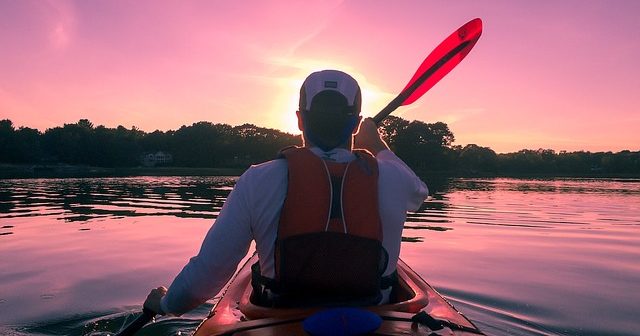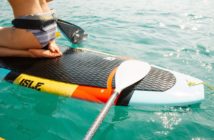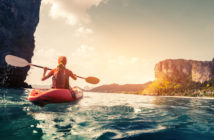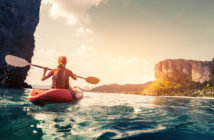Today, we want to share information about the types of kayaks that are out there in the marketplace.
Our complete guide will help you to decide which type of kayak is right for your needs and preferences.
Contents
An Overview of Kayaks: And Why We Love Them
Kayaking is all about paddling a kayak through the water.
It’s an enjoyable activity which offers the perfect blend of excitement and relaxation. People who love to kayak know that it’s the ideal way to get fresh air and healthy exercise in a range of inspiring settings. If you love the feeling of being out on the water, you’ll probably find that the kayaking experience delivers pure pleasure.
When you paddle a kayak, you’ll be able to glide through rivers, lakes and oceans and see some amazing sights. Drink in the beauty of distant landscapes, get close (but not too close!) to wetland birds and admire floating lilies and seagrasses. If you want a rest break, steer your kayak towards a nearby beach…and then prepare to soak up the sun’s golden rays on the sand. Kayaks are portable, so you’ll have the capacity to be spontaneous.
Kayaking will provide you with an immersive experience, as you’ll be “in” the water, rather than being on top of it! Paddling a kayak will also strengthen your upper body, by toning your obliques, triceps and lats.
When you get tired of paddling, just chill out and drift for a while. Kayaking may be adventurous or mellow (or anything in between), depending on where you kayak, as well as water conditions and weather conditions. A great kayak which is right for your preferred style of kayaking will help you to get the most from every single outing.
Whether you’re a kayaking newbie, intermediate or expert, we hope that you will enjoy our complete guide to the types of kayaks. We’re here to give you all of the hard facts that you need, in one convenient place.
Touring Kayaks (Sea Kayaks)
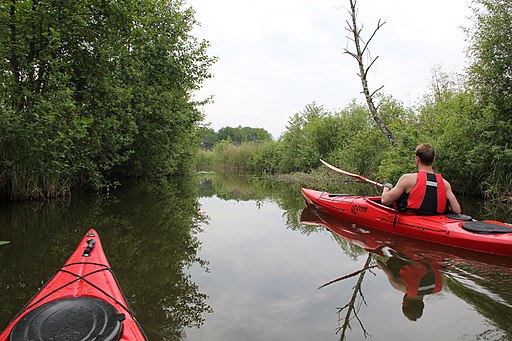
Source: Aquarius (Author: Own Work)
Touring kayaks are also known as sea kayaks and they were created for paddlers who want to explore open water, such as oceans, bays and lakes. These compact boats are “seaworthy”. They feature covered decks, as well as the capacity to add optional spray decks (spray decks are boat covers which are waterproof and flexible; these covers are crafted with holes for the waists of passengers). If you decide to add a spray deck to a touring kayak, you’ll find that it keeps water out of your boat. Some touring kayaks may come with spray decks.
While touring kayaks aren’t as maneuverable as some other styles of kayaks, such as whitewater kayaks, they:
- go faster
- hold more cargo
- make straight-line paddling simple
- are quite comfortable for longer outings
If you want to do sea trips which are hours in length, up to weeks in length, a touring kayak may be right up your alley. A kayak of this type will definitely be ideal if you want to enjoy weekend or day trips of twenty miles in distance or less. A touring kayak is best for someone whose skill level is intermediate to advanced. Storage in these kayaks is generally moderate to high.
These kayaks may be solo designs or they may hold up to a trio of paddlers, plus gear. Typically, touring kayaks range in length from ten feet to twenty-six feet. Styles from ten to eighteen feet are usually solo watercraft, while the longer kayaks are meant for more than one paddler. The width of touring kayaks is usually between twenty-one inches to thirty-six inches.
How to Find the Right Touring Kayak
First, decide if you want to paddle solo or travel with one other paddler (or two other paddlers). When you make this important decision, you’ll be able to streamline the comparison-shopping process. Getting a handle on the size of kayak that you want should be priority one.
Another prime consideration is which material the hull of a touring kayak is made from. In general, hulls for these styles of kayaks are made from composite (Fiberglas is a popular choice) or plastic (such as polyethylene). The composite designs usually cost more, but are generally lighter in weight. Light weight comes in handy when it’s time to put a kayak on the roof rack of a vehicle. Also, composite hulls tend to be very attractive, with glossy finishes. Some people find that composite finishes boost speed.
Composite is stiffer than plastic and this stiffness may positively impact the responsiveness of the vessel. The “con” of stiffness (rigidity) is that composite hulls tend to be less forgiving in situations where kayakers get to close to rocks or drop their boats (typically, while trying to load them onto their vehicles). Plastic hulls tend to sustain less damage from impact. Plus, scratches to plastic hulls are generally simple to fix. Composite repairs may be more expensive.
You’ll also need to decide between a skeg or a rudder. Actually, you may not want either, but we think that you should choose one or the other. Kayakers argue about what’s best. Rudder styles allow kayakers to control, or partially control, which directions their kayaks go in. Rudder-equipped touring kayaks have foot pedals which are located inside of their cockpits and the foot pedals make it easy to move rudders to the left or right. Also, it’s possible to take a rudder right out of the water if you’re not interested in utilizing it.
With a skeg, which is a keel that retracts, you’ll gain assistance with keeping your kayak in a straight line. The process of going in a straight line is referred to as tracking. A skeg is mostly utilized when weather conditions are on the windier side. The skeg can’t be adjusted in a side-to-side fashion, like rudders can be. With a skeg, you will need to turn your vessel with your paddle and body.
If you go for a style with neither, you’ll find that it’s tough to control your kayak when winds get strong.
White Water Kayaks
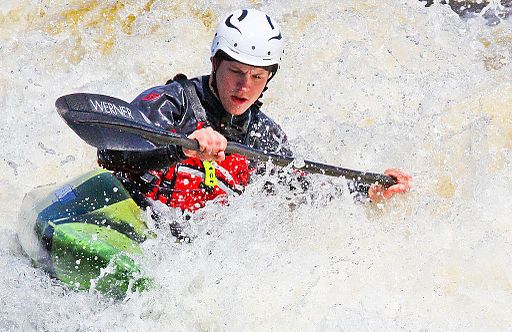
Author: cjuneau
With white water kayaking, there is more intensity. Good white water kayaks are tough enough to hold up in challenging, white water conditions, from active water to ultra-extreme white water! These kayaks are responsive enough to help paddlers navigate effectively. With white water rafting, the skill of the paddler really matters and the best white water kayaks help users to put their skills into action effectively. These kayaks differ from other styles because they usually have shorter keels which simplify the turning process. Also, with one exception (Long Boats), white water kayaks tend to lack the overall length of other types of kayaks, such as touring kayaks.
Shorter kayak lengths make it easier to do movements in the water. It is simpler to run rivers in white water kayaks.
Within the main category of white water kayaks, there are subcategories, which are Play Boats, River Runners, Creekers and Long Boats.
Which Style is Best for You?
- Play Boats are white water kayaks which are best for paddlers who want to do an array of technical moves in particular spots. If technical moves are your goal, rather than travelling the length of part of a river, or an entire river, then a play boat will be a practical option.
- River Runners are down-river vessels, which help paddlers to access speed, catch eddies and surf waves.
- Creek Boats are perfect for whitewater which is steep, tight and technical. These boats roll easily and are very “reactive”.
- Long Boats offer good speed and glide through white water. They are fast, heavier-than-average and popular choices for races. These boats are nimble, narrow and long.
How to Shop for a Whitewater Kayak
You should choose the right type of whitewater kayak, whether it’s a play boat, river runner, creek boat or long boat. As well, you should purchase a design which is a perfect match for your skills. Don’t buy a design for intermediate users if you’re a newbie.
If you want to enjoy travelling the length of white water rivers, rather than doing a lot of technical feats in specific parts of the water, you should look for a style with a displacement hull. This style features curves that are continuous, from side to side and front to back. A whitewater kayak with this type of hull will make it easy for you to move through waterways in an efficient manner. Planing hulls with flat bottoms are available, but they make it tougher to maintain tracking which is straight. A planing hull will be ideal if you want to do play movements and surf movements.
Also, think about length in terms of speed. When a whitewater kayak is longer, it will go faster. The length of the waterline of a whitewater kayak will play a big role in how fast the vessel goes.
Outfitting is also something that you should pay attention to. The kayak that you choose should be renowned for its comfort. Some people test out kayaks in their communities and then buy them online for cheaper prices. If you do test out a whitewater kayak before you buy, don your paddling gear before you sit in it. Don’t wear your street clothes. In lieu of trying before you buy, read plenty of customer reviews. See what real-life buyers have to say about the outfitting of specific models, as premium comfort and the quality of outfitting are linked.
You should also think about cargo space. Will a specific whitewater kayak that you are interested in hold all of the gear that you want to bring along. Will the weight of your gear impact performance?
Lastly, will you need to buy a skirt for a new whitewater kayak? Some styles may be compatible with a skirt that you already own. However you get your skirt, it should be simple to put on and remove.
Inflatable Kayaks
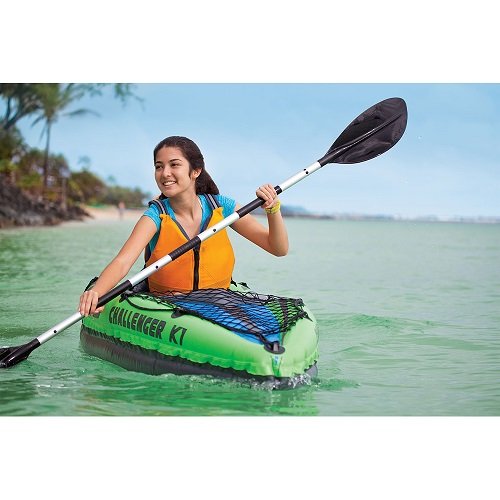
Source: Amazon
If you want affordability and the ultimate in portability, an inflatable kayak may be exactly what you need. These kayaks are definitely the most inexpensive styles, because they don’t feature the heavy-duty materials found in costlier kayaks. However, despite their less-pricey materials, the quality of best-selling, highly-rated inflatable kayaks is typically exceptional. While quality will vary greatly from model to model, today’s most impressive inflatable kayaks are very high-tech. They offer performance on a par with traditional kayaks with hard shells.
You’ll inflate this type of kayak before you use it and deflate it when you’re done. That’s simple enough, right? While these kayaks are probably more suitable for beginners who want to kayak once in a while, rather than tackling wild whitewater or doing races, they offer ease and low price to everyone.
Pros and Cons of Inflatable Kayaks
These kayaks are simple to store in compact spaces. As well, they are easy to move from place to place. For example, if you want to, you can take a deflated kayak on a plane with you, in order to use it on holiday. As well, most inflatable kayaks have construction which is quite hardy. They are rugged and they are built to stand the test of time. We’ve already talked about how affordable these designs are. Their affordability is definitely a key “pro”. As well, they tend to perform well, although performance may vary from kayak to kayak. Lastly, they are light in weight and fun to use.
Now, let’s talk drawbacks. An inflatable kayak may not go as fast as a high-quality kayak with a hard shell. If speed isn’t your primary consideration, this shouldn’t be a big deal. For the recreational user, an inflatable style should offer more than enough speed. Also, punctures are possible, as they are possible with all inflatables. However, it’s pretty easy to repair punctures if they happen. Some inflatable kayaks come with repair kits that are easy to use. You’ll find that an inflatable typically requires less maintenance than a hard-shell kayak.
Another potential downside of an inflatable is its width, which is usually wider than a hard shell design. The extra width is designed to provide more stability. However, some kayakers prefer slimmer boats which are more agile.
How to Shop for an Inflatable Kayak
Like other styles of kayaks, inflatables come in solo designs (one seat) and tandem styles (which hold two or three paddlers). Decide whether you want a solo or tandem design. Then, think about the type of kayaking that you want to do. Are you interested in adventurous kayaking in rougher water conditions, or do you want to paddle around waterways which are relatively calm? If you want rugged, adventure-style performance, you’ll need to look for an inflatable which is designed for harder use. These kayaks are definitely out there. If you want that type of rugged design, you may want to choose a kayak which is compatible with a spray skirt. Adding a spray skirt will help to keep you dry while you paddle in rougher water conditions.
As well, if you want an inflatable kayak for whitewater kayaking or other intense forms of kayaking, you may want to choose a model which features a self-bailing system. This system will help to keep your kayak free of water and functioning well.
You should also consider the length of the kayak, as well as its quantity of cargo space. Is the length right for you and is there enough room for the gear that you want to take along? Longer styles tend to ‘wag” less, but are harder to carry around when they are inflated. Cargo space may vary, from room for basics (like water and snacks) to bigger cargo storage space, which is sufficient for camping gear.
Also, look at how to inflate specific styles. Is it possible to inflate them completely in five to ten minutes, or is the process more elaborate? You’re going to be doing the inflating, so you will need to know that the process is streamlined enough to be simple and convenient. Usually, it’s possible to blow up these inflatables in mere minutes, but designs vary. Be sure that you understand what you’ll need to do before you are ready to put your kayak in the water. Also, are inflating accessories included, or will you need to buy them separately?
It’s smart to go for a model that sells well and gets excellent reviews. Take the time to do some research before you buy. Also, consider the reputation of the manufacturer. Does the maker of an inflatable kayak that you like have a proven track record? Actually, no matter what type of kayak you want to buy, you should consider brand reputation.
Researching manufacturers will be smart. Visit their official websites and hunt for reviews. It’s easy to learn about these companies and what real-life customers think of them.
Sit On Top Kayaks
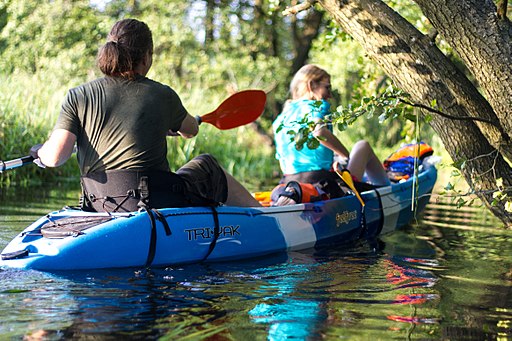
Source: Aquarius, Author: Own Work
If you want a kayak which is really easy to get in and out of, then you’ll benefit from discovering the features of “sit on top” kayaks! These kayaks have the traditional hull shape of other kayaks. However, they differ from other kayak types in terms of their seats. With the sit on kayak, there is a depression on the top which is “molded in”. Usually, sit on styles are crafted from heavy-duty plastic that is rotationally molded…and not too expensive. Sometimes, sit on kayaks are made from Fiberglas.
If you find it tough to get in and out of typical “sit in” kayaks and you want something which is easier to use, this style of kayak will suit your needs. These styles of kayaks are recreational. They aren’t usually right for serious kayakers who do long treks in a range of water and weather conditions. While they aren’t perfect choices for whitewater and long-haul adventures on open water, sit on top kayaks are great for recreational usage, as they are fun, simple to utilize and stable.
Pros and Cons of Sit On Top Kayaks
These kayaks have plenty of benefits. They are ideal for family-style fun. For example, if you’re planning to take turns with the kayak, with friends or family, the ease with which people can get on and off a sit on top kayak will be a big “pro”. It’s simple to get on these boats, even when water is deep. They are good choices for good times near a cabin. Lots of people buy sit on top kayaks for their kids.
Also, these styles offer plenty of comfort, as long as water and air are warm enough. You’ll be more exposed to the elements in this type of kayak, as you’ll be sitting higher. In addition, these types of kayaks come with scupper holes, so they are self-draining. You’ll never need to pump out H2O.
Now, let’s talk about possible “cons”. First off, you’re going to get wet when you use this type of kayak, so keep this in mind. Also, you will have a higher center of gravity than you would have in a “sit-in” style. This means less stability and a higher risk of capsizing. Sit-in kayaks put people right in the water, rather than above it. Sit on top kayaks don’t put kayakers in the water, so they aren’t good choices for certain maneuvers, such as rolls. If you want to do a lot of fancy moves in your kayak, skip the sit on top style and go for a sit-in kayak which is compatible with a spray skirt.
If casual enjoyment is your goal and you’re not a serious kayaker, you’ll find that a sit on top style is so much fun to use, by yourself or with a group. Like other kayaks, sit on top styles come in different lengths and are available in solo and tandem styles.
Usually, these styles have some room for cargo. However, it’s sometimes hard to access the storage space. As well, sit on kayaks are generally heavier than other kayak styles.
How to Shop for Sit On Top Kayaks
There are sit on top kayaks for basic family fun and there are styles which are made for specific purposes, such as camping, touring, diving, surfing and fishing. You will have choices, so think about what you want to do with your kayak and then start comparison-shopping for a style which is ideal for your needs. When you know what you want, it will be easier to narrow the field.
Next, decide if you want a solo style with room for one paddler or a bigger, tandem style. Once you make this important decision, think about the construction and performance of specific sit on top kayaks. While you will want some stability, we don’t recommend choosing the widest kayak on the market, as you should be able to learn how to balance a narrower kayak in no time flat and a narrower style will provide more speed in the water.
Also, make sure that any kayak which interests you is designed to support your weight. Product descriptions for sit on top kayaks should offer weight capacity information.
Longer kayaks go faster. Shorter ones are simpler to manoeuvre. Keep this in mind when you shop around and then make a choice that works for you.

